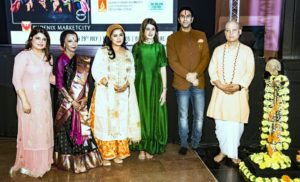The first day of the two-day art festival, Ekam, curated and organised by the superbly creative Kalashree Lata Surendra opened with Lataji saying, “If the mountain does not come to Mohammed, Mohammed must go to the mountain. That’s what this dynamic dance teacher to actress Aishwarya Rai Bachchan has done, taking art from the confines of an auditorium to a specially created event space in Dublin Square, Phoenix Market City, Kurla, Mumbai.”
This one-of-its-kind event was curated by Lata Surendra (performing arts), Jalpa H Vithalani (visual arts) and Smiita Gik Parikh (literature) and organised by Anjali Bharatanatyam Research Trust. The festival aimed at synergising the three art forms, thereby highlighting oneness and unity.
I was fortunate to be a part of this event inaugurated by Prabhu Surdasji (ISKCON, Juhu) and graced by actors Sudha Chandran, Vidya Malawde, Girija Oak Godbole, Preetika Rao, Shobha Arya and Manju Lodha.

The event began with Smita Shastri’s Mayura Kavuthuvam. Journey of a Woman by Neha Banerjee brought together poetry and painting in traditional Kathak format. Siva Panchaksharam and Diksha through Kathak by Marami Medhi and Meghranjani Medhi stood out for its unique choreography. The special effects by the video team added magic. Pushkar Saxena’s painting Krishnamayi Radha was evocatively brought to life by Uma Dogra. Nivedita Mukherjee showed how paintings and sculptures are interconnected through Odissi.
Kandinsky was innovatively interpreted by Ankit Pahadia (Chhau) and Sunil Sunkara (Kathak). The segment where the disciples of Gita Vijayshanker enacted Krishna and Arjuna moving towards the audience in chariot formation in Mohiniyattom style had great impact. While Chhaya Khanvate’s disciples depicted Vittala, Rohit Gopinath and team showcased the energy of Devi, Anand Satchidanandan and Jayalakshmi connected the lines of ballroom and Bharatanatyam innovatively in a tillana.
Chitrangadha, conceptualised by Swapnokalpa Dasgupta and presented by her disciples (Odissi), and Manipuri by the disciples of Latasana Devi and Purbita Mukherjee visualised Rabi Chitra, the poems and paintings of Tagore. Subtitles facilitated better understanding.
The performance by Rohan Pawar and his team stole the show with their aerial ‘kinesthetic’ and energy. Interpretation of blue lotus as Lord Vishnu in a beautifully choreographed Bharatanatyam ensemble with Guru Suman Badami in the lead left the audience asking for more.
Day two began with Vyjayanti Kashi’s Kuchipudi performance. The shattered aspirations of newly wed Gandhari on seeing her husband blind were evocatively etched by her. Naga Nrittam with the awakening of Kundalini was chosen by Mohiniyattam dancer Jayaprabha Menon. Amir Khusro’s Sufi composition was brilliantly executed by actress and Kathak exponent Nandita Puri with the images of sun and moon by Laurel Burch in the backdrop.
Pavitra Bhatt tried to depict Nandanar’s devotion through her painting, Step of Faith, to convey how the power of bhakti can move mountains. Mitali, Shreya and Atrrayee, disciples of Shubhada Varadkar, depicted Ashtabhuja Durga of Raja Ravi Varma, moving in Odissi formations from unhurried grace to a spirited climax.
Pahari paintings formed the backdrop for Ashtanayikas presented in Kathak format by the disciples of Renu Sharma. The concept, choreography and costumes were equally creative. Anusua Roy interpreted Jamini Roy’s painting on the representative mother and child Krishna through Manipuri medium.
Bindu was a well-coordinated group presentation by Sanskriti Dance Academy. The fact that everything converges to a dot was conveyed through effective use of the stage space with measured movements and geometric formations. Slide projections of paddy fields and greenery set the tone for the performance by Gita Venkateshwar and disciples.
The Scream by the disciples of Padmini Radhakrishnan, Diksha by Shyama Sugesh and Deepa Annadatte and the finale by Manisha Jeet and disciples were beautiful themes, explored creatively, were well-received by the audience.
A panel discussion on communication in art, literature and performing arts had Smiita Gik Parikh reciting her poem, urging Lata Surendra to develop it through dance and depicting how two diverse mediums could merge to convey an embedded message.
Manju Lodha’s poem on Draupadi was explored through impromptu abhinaya by Lata and Nandita Puri. Spot painting initiated by art curator Jalpa Vithalani had the journey of dancing feet from ‘still to stillness’ come a full circle.
Talking about the perfect concept of Ekam – From Still to Stillness, Lata Surendra, said, “I wanted to bring forward a festival not only for dancers and dance lovers but also for art lovers. This is for the first time that choice paintings of renowned artists from across the globe were brought to life by dancers using their loved and mastered dance forms. I’m glad the festival was received well by art-lovers of Mumbai and I wish that with the support of Phoenix Market City, Kurla, I can make this an annual event.”
Though Amruta Fadnavis, wife of Maharashtra chief minister was to grace the finale, she unfortunately could not make it. An avid art-lover, she sent a message, praising the festival which brought dance, poetry and painting together on a single platform.
I feel humbled to have been a part of this wonderfully enriching festival and am sure that soon we shall see Lata Surendra bringing dance hand-in-glove not just with painting and poetry but even music and songs. Lata Surendra is indeed one of the key torchbearers of ar. Wishing one of my favourite people, Lataji, all the best for the future.